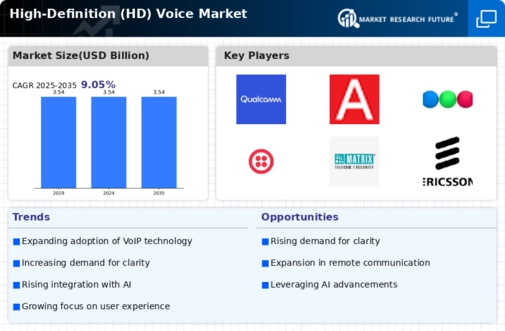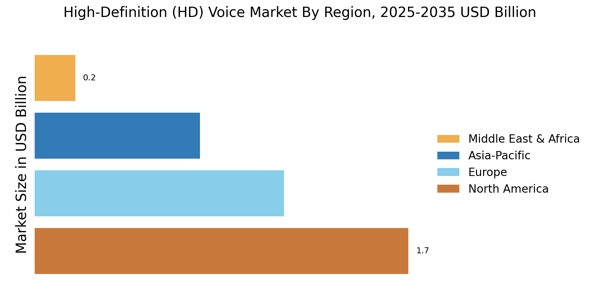Emergence of 5G Technology
The High-Definition (HD) Voice Market is poised for growth due to the emergence of 5G technology. The rollout of 5G networks is expected to enhance the quality and reliability of voice communications, making HD voice services more accessible and appealing. With significantly lower latency and higher bandwidth, 5G technology enables clearer and more stable voice calls, which is crucial for HD voice applications. As telecommunications providers invest in 5G infrastructure, the demand for HD voice services is likely to increase. Market analysts predict that the 5G market will reach USD 700 billion by 2026, with HD voice being a key component of this growth. This technological advancement is anticipated to reshape the landscape of voice communications, driving the adoption of HD voice solutions across various sectors.
Rising Adoption of VoIP Services
The High-Definition (HD) Voice Market is significantly influenced by the rising adoption of Voice over Internet Protocol (VoIP) services. As businesses seek cost-effective communication solutions, VoIP has emerged as a preferred choice, offering enhanced features such as HD voice capabilities. The increasing penetration of high-speed internet and the proliferation of smartphones have further facilitated this trend. According to recent data, the VoIP market is expected to reach USD 100 billion by 2026, with HD voice services playing a crucial role in this growth. Organizations are increasingly recognizing the value of HD voice in improving communication efficiency and customer satisfaction. Consequently, the demand for HD voice solutions is likely to rise, propelling the overall market forward. This trend indicates a shift towards more sophisticated communication technologies that prioritize sound quality.
Growing Focus on Customer Experience
The High-Definition (HD) Voice Market is witnessing a growing focus on customer experience as a key driver of market growth. Companies are increasingly aware that superior voice quality can significantly enhance customer interactions, leading to higher satisfaction and loyalty. As a result, businesses are investing in HD voice technologies to differentiate themselves in a competitive landscape. Enhanced voice clarity and reduced background noise contribute to more effective communication, which is essential in customer service environments. Market Research Future indicates that organizations that implement HD voice solutions report a 20% increase in customer satisfaction scores. This emphasis on customer experience is likely to propel the adoption of HD voice technologies, as companies strive to meet and exceed customer expectations in their communication strategies.
Advancements in Voice Processing Technology
The High-Definition (HD) Voice Market is experiencing a surge due to advancements in voice processing technology. Innovations in algorithms and codecs have enhanced the clarity and quality of voice communications, making HD voice more appealing to consumers and businesses alike. For instance, the introduction of wideband audio codecs has improved the frequency range of voice calls, resulting in a more natural sound. This technological evolution is expected to drive market growth, as organizations increasingly adopt HD voice solutions to enhance customer interactions. Furthermore, the integration of machine learning in voice processing is likely to optimize call quality and reduce latency, thereby attracting more users to HD voice services. As a result, the market is projected to witness a compound annual growth rate (CAGR) of approximately 15% over the next few years.
Integration of HD Voice in Unified Communication Platforms
The High-Definition (HD) Voice Market is being propelled by the integration of HD voice capabilities into unified communication platforms. As organizations seek to streamline their communication processes, the demand for solutions that combine voice, video, and messaging is on the rise. HD voice enhances the quality of voice calls within these platforms, making them more effective for collaboration. The market for unified communication is projected to grow significantly, with estimates suggesting it could reach USD 50 billion by 2025. This growth is likely to be accompanied by an increased emphasis on HD voice features, as businesses recognize the importance of clear communication in remote and hybrid work environments. The seamless integration of HD voice into these platforms is expected to drive further adoption and innovation in the market.


















Leave a Comment